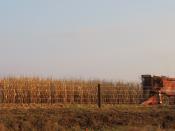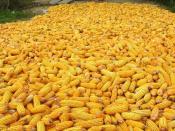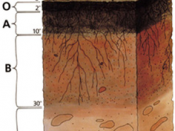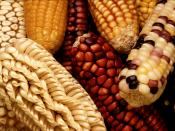Curtis July, 16, 2001 WR 115 CORN One of the main staples of the American diet would have to be corn. Being raised and having worked on a large grain farm in central Iowa, I have had a lot of experience in the production of this crop. The main steps involved include variety selection, soil preparation, cultivation, harvest, drying and storage, and of course, selling your crop at an optimal price.
The first step is selecting the variety to be planted. Agronomists over the years have developed hundreds of different and distinct breeds of corn. Normally the selection can be narrowed down to a hand full, depending on what part of the world the crop is to be grown. Some things to take into consideration include; drought or excess moisture resistance, short or long maturing rate, ear retention, wind resistance, and of course yield. These are just a few characteristics to consider.
But you can't have it all; you must weigh benefits and weaknesses. It is truly a gamble, with Mother Nature as the dealer.
Soil preparation involves several stages. First is the turning of the topsoil, or plowing. Second is a pass with an implement such as a disk, or harrow to break up the large clods of soil into a finer texture. Then often one more pass with a tool known as a spring tooth, or harrow. It is often at this point that fertilizer and a pre-emergent herbicide is applied. A pre-emergent herbicide is one that eradicates the growth of weed seeds at the moment they germinate. They never see the light of day. The main nutrient that the corn plant requires is nitrogen, along with potash and phosphate.
The plants would grow without the addition of fertilizers and pesticide, but with the meager yields you would obtain, you would be out of business in a few short years.
The next few weeks are mainly up to the weather. Several inches must fall, and many hours of soil warming are needed. The excess of lack of either, can easily bring this growing season to an abrupt end.
Once your crop has finally broken out of its dark hiding place, so will many other plants that will vie for all the food, water, and sunlight they can grasp. The age-old method of cultivation, a post-emergence pesticide application, or a combination of both normally controls these weeds. Even thought the soil was treated at planting time, many weed seeds germinate after the effectiveness of the pre-emergence herbicide has diminished.
With the desired plants hopefully doing well, and as much of their competition as possible extinguished, it is time to wait, and hope that the sky above cooperates. By the time fall arrives, barring and insect infestations, or hailstorms, it is time to set one's sights on the harvest. The once green corn plants begins to die in the fall, and are transformed into brown, dry, brittle stalks.
Harvest season is a very busy time of year. One thing that you can ill afford to happen is equipment break down that could cause you to loose any precious time. One main point to bear in mind is that the ears of the plant can only be efficiently snapped from the stalks during warm, dry, fall days. Mother Nature needs to be smiling on you at this time of year.
If the crop is harvested too early, additional expense will be incurred by the process of drying of the grain.
If one waits to long, the grain will dry on the stalk naturally, but the ears simply falling off the plant lose much grain. This is indeed what nature intended, but not what man desires.
Corn with a moisture content of more than thirteen percent, stored for any period of time, will rot. Much of the grain harvested in a typical year comes out of the field with moisture content of sixteen to twenty five percent. The process of drying and storage can be a very expensive process. Not only the initial cost of the facility, but the mere volume of natural gas or propane needed, and the electricity consumed can be staggering.
Once all is harvested, dried, and stored, it is time to watch the market, and hope to get a fair return for your labor. And it is time to begin the whole process over again with the selection and purchase of a seed variety for next years growing season.




